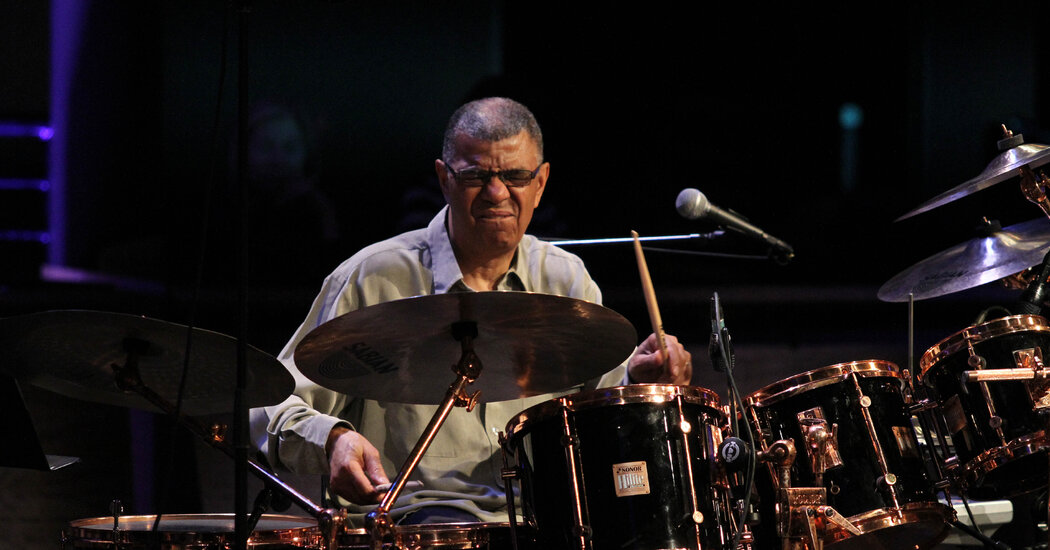Jack DeJohnette, an early member of Chicago’s experimental collective the Association for the Advancement of Creative Musicians (AACM), developed an adaptable style that shaped his career as one of jazz’s great instrumentalists.
Originally a pianist, DeJohnette, who died on Sunday at 83, gained recognition in the mid-1960s for fluid, expansive drumming for the saxophonist and flutist Charles Lloyd. By the late 1960s, DeJohnette brought flammable playing to Miles Davis’s so-called Lost Quintet, a live ensemble that was never captured on record. This role cemented his drumming style for years, showcasing his ability to blend rock and funk rhythms with exploratory, ignitable jazz.
His first six solo albums revealed a fully formed artistic vision, both as a composer and drummer, embracing the 1970s spirit of experimentation and undiluted improvisation. As the de facto house drummer for two stylistically contrasting jazz labels, ECM and CTI, DeJohnette’s seemingly ceaseless creativity and seamless command of funk and jazz made him one of the most sought-after drummers for both live performances and studio sessions.
Starting in 1976, DeJohnette cemented his role as an ECM bandleader, releasing 12 albums that featured all-star lineups and a visceral blend of harmonically and rhythmically forward-thinking jazz. While playing with the popular Keith Jarrett Trio, later known as the Standards Trio, DeJohnette pursued an independent artistic path, focusing on organic world music released on his own Golden Beams label.
DeJohnette’s late-career resurgence included a 2013 AACM reunion on “Made in Chicago,” the 2015 trio session “In Movement” with Ravi Coltrane and Matthew Garrison, the solo piano reflection “Return” and a quartet album inspired by his upstate New York home, “Hudson.”
Here are seven essential examples of his 50-plus years of recorded work.
‘Demon’s Dance’ (1970)
The title track to the alto saxophonist Jackie McLean’s album “Demon’s Dance” gives full berth to DeJohnette’s practically gleeful ride-cymbal beat. His hi-hat, bass drum and toms fuse together for rhythmic permutations that combine the elegance of Tony Williams with the fire of Elvin Jones, each variation a masterstroke of time and tension.
 Listen on Spotify, Apple Music or YouTube
Listen on Spotify, Apple Music or YouTube
‘Lungs’ (1975)
In 12 minutes of open-ended improvisation over the briefest of melodies, DeJohnette cajoles the keyboardist Jan Hammer and the guitarist John Abercrombie on Abercrombie’s 1975 release, “Timeless.” The mood is volatile and the tempo lighting fast as DeJohnette draws on a well of power, imagination and blistering technical skill to drive the track to memorable heights. When it collapses into ambient tones and shapes, DeJohnette caresses the cymbals, snare drum and tom toms for a potent lesson in overdrive, exhaustion and release — colorful percussive commentary.
 Listen on Spotify, Apple Music or YouTube
Listen on Spotify, Apple Music or YouTube
‘Maya’ (1981)
The opening track of “To Be Continued” unfolds like a celestial dance. Miroslav Vitous’s bass plunges into the abyss, Terje Rypdal’s guitar ascends into the ether and DeJohnette — equal parts navigator, shaman and engineer — drives the music with rubato flurries of cymbals, thunderous rolls and full-kit incantations, transforming the performance into a transcendent invocation.
 Listen on Spotify, Apple Music or YouTube
Listen on Spotify, Apple Music or YouTube
‘Nothing Personal’ (1987)
The saxophonist Michael Brecker’s 1987 self-titled LP assembled an A-list of jazz royalty: Charlie Haden, Kenny Kirkland and Pat Metheny. Their version of the Don Grolnick composition “Nothing Personal” opens as a musical game of hide-and-seek, with the musicians stating the slippery melody. DeJohnette’s beautifully recorded drums and cymbals run routs around the players, evoking a caffeinated cat destroying furniture. Though he lays low for the solo introductions, he soon ratchets the intensity to astounding peaks — delivering full-set punctuations, shimmering cymbal glissandos and heated snare and bass drum combinations that explode and collapse.
 Listen on Spotify, Apple Music or YouTube
Listen on Spotify, Apple Music or YouTube
‘Games’ (1988)
The bassist Dave Holland’s 1988 trio release, “Triplicate,” with DeJohnette and the alto saxophonist Steve Coleman, showcases the drummer’s ability to craft a languid swing pulse laced with evocative jabs and punches. When DeJohnette rolls forcefully around his drum set during rests, the notes explode from left to right and back again, cymbals splashing, snare drum cracking, tom fills ricocheting, like a roller coaster.
 Listen on Spotify, Apple Music or YouTube
Listen on Spotify, Apple Music or YouTube
‘Dancing’ (1990)
Playing the cymbals as only he could, in his practically pointillist style, DeJohnette makes his instrument and this song float, shimmer and sway, as the guitarist Pat Metheny and the pianist Herbie Hancock further extend its cerebral but meaty mood. One of seven selections from DeJohnette’s 1990 release, “Parallel Realities,” “Dancing” generates heat while spreading the groove like a fast-moving mushroom cloud.
 Listen on Spotify, Apple Music or YouTube
Listen on Spotify, Apple Music or YouTube
‘If’ (2007)
Trio Beyond, a group featuring DeJohnette, the guitarist John Scofield and the organist Larry Goldings, was a Tony Williams tribute band of sorts. On “If,” DeJohnette lays down a sizzling medium-tempo hard-swinging rhythm that both supports and challenges the soloists. DeJohnette’s ability to extract a world of color, drive and sense of musical skirmish from a single cymbal is one of his trademarks — and it’s on display in prime form here.
 Listen on Spotify, Apple Music or YouTube
Listen on Spotify, Apple Music or YouTube
The post Jack DeJohnette: 7 Essential Recordings appeared first on New York Times.




